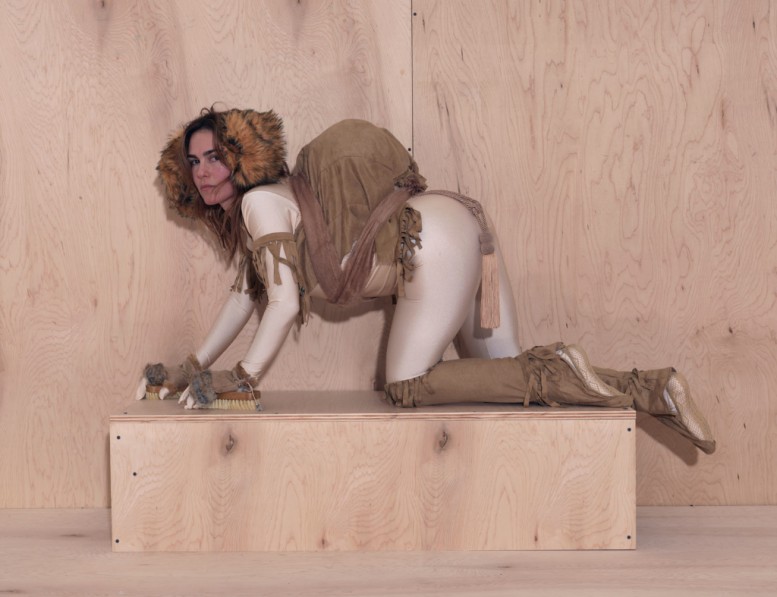Olaf Breuning is one of those mystical artists with a gift that is both totally innate and at the same time seems to involuntarily possess the artist – as if he were haunted by the immense creativity that overcomes him. This is evident in the art that he has created and presented in over 250 exhibitions, either solo or group, since his professional career started in the late 1990s. The Swiss-born, New York based artist, has created everything from creatures made out of rakes and cardboard, to films that explore the thin line between reality and fiction, bizarre photographic explorations, and installations made from kitchen appliances. Now Breuning brings his phantasmagorical world to Dubai for the very first time with a striking and magical exhibition at Carbon 12 gallery. “Camelops Femina,” as the exhibition is called, is a fictional exploration of pre-conceived ideas and iconography that digs back 10,000 years in history to excavate an extinct species of Camel that once roamed North America. The images, which were created exclusively for this exhibition, are distinctly Breuning in the quotidian and strange manner of the composition of the photographs where models are dressed like desert sheiks or Bedouin gypsies to represent the imaginary extinct species of camel. This wonderful exhibition is on view now at Carbon 12 in Dubai. Pas Un Autre got a chance to speak with the artist himself in the following interview.
PAS UN AUTRE: You’ve had over 250 exhibitions since the late 90s and this is your first in the Middle East – do you have any expectations – trepidations?
OLAF BREUNING: Trepidations? Uhh…. I will have them if there would be a reason! And expectations? No never have them. The most important for me is that I do an artwork I like. And so far I love the "Camelops Femina."
AUTRE: Your work experiments with, or is a reflection of, popular culture – what are some of your predictions as to where pop culture will go in the next 10 years?
BREUNING: Haha, pop culture...I am not sure…if it still exists…the art industry is pop culture itself. For example Andy Warhol’s work in the seventies was something different because the self-awareness of art itself was still very conservative, but today there seem to be no borders…just different strategies produced and read by different groups of people. Random, like our time in general.
AUTRE: What are some of your favorite inventions of the last 10 years?
BREUNING: To be able to challenge my small brain and come up with always new ideas responding to me and the time I live in.
AUTRE: Have you always want to be an artist? Can you remember the first time you said to yourself: “I want to be an artist”?
BREUNING: I think I never said that, it was always a natural situation. Maybe I am just a natural self-centered person who cannot do anything else than speak about himself. No, no I am a modest person.
AUTRE: What is your ultimate goal as an artist – is there a specific message you want to communicate?
BREUNING: No, no message! I do art to go through this life on my terms. Sounds dramatic, but it is fun and addictive. I feel free as an artist and I hope I can do so until my last day.
AUTRE: Why is art important to society?
BREUNING: Well, I am not a politician, but would I would say: EDUCATION! Whatever that means, just to give different points of views to things.
AUTRE: Where do you find inspiration or creativity?
BREUNING: Mostly at Balthazar in New York, the breakfast restaurant I’ve gone to for 12 years from Monday to Friday. This is the time where I have my first coffee and make my drawings for new ideas.
AUTRE: Is art a product or can a product be art – or both?
BREUNING: Art is whatever you say is art....no borders, just a matter of definition.
AUTRE: Your art deals a lot with the human condition in the 21st century – is there something unique about this time or perhaps different than other epochs?
BREUNING: Yes! THE INTERNET, it changed the way we see the past, the now and the future…so long we are online.
AUTRE: What can we expect from your show Camelops Femina at Carbon 12?
BREUNING: I show with my kind of humor and I hope people in Dubai like my humor.
AUTRE: What’s next?
BREUNING: One day New York, one day Toronto, four days New York, one week Japan, one week Switzerland....and after that I have to focus on a show in August at the Paul Klee museum in Switzerland.... have to make some art!
Text by Oliver Maxwell Kupper. Camelops Femina will be on view until April 30, 2013 at Carbon 12 Gallery, Warehouse D37, Alserkal Avenue, Street 8, Al Quoz 1, Dubai contact kourosh@carbon12dubai.com for all inquiries










